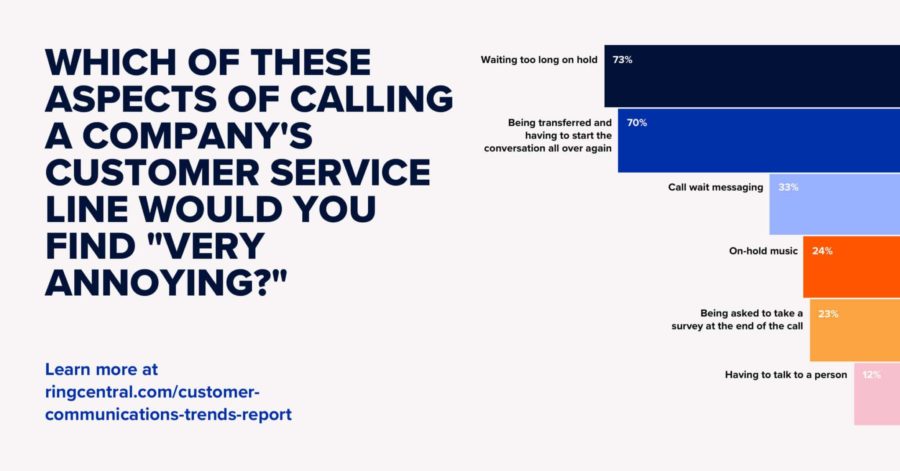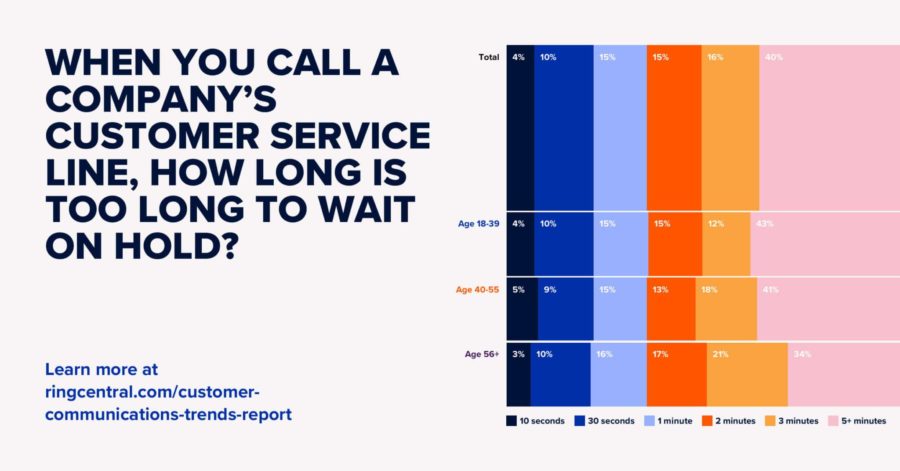It’s no secret that offering high-quality customer service is an indispensable part of building a thriving, sustainable business.
Good service enhances the customer experience, which, in turn, drives up customer retention, improves positive word-of-mouth, and, most importantly, boosts business revenue.
Thanks to advances in digital technology, businesses have never had more ways to deliver the level of seamless service that keeps customers coming back for more. Back in the old days, customers usually had to settle for an in-store consultation or painfully long hold times during store hours whenever they had a question about a product or needed to arrange a repair. Today, customers expect a range of convenient options for when they interact with businesses, whether it be live chat, phone, or a self-service knowledge base.
But when you’re running a small to midsize business (SMB), it’s generally impractical to build an all-inclusive customer service program that incorporates every major customer communication channel. Instead, you have to be selective and pick the types of interactions that best meet your business and customer needs.
In this post, we’ll explain why figuring out the right customer service model is so vital. We’ll also run through the benefits of different types of customer service and offer some guidance on how to successfully implement them within an SMB. By the end of the post, you should have a better idea about which approach to customer service makes the most sense for your organization.
What we’ll cover:
- Why finding the right customer service model is so important
- 4 types of customer service to use in your SMB (with examples from real companies)
So let’s start with a reminder of why finding the right balance of customer service types is so crucial for business success.
⭐️⭐️⭐️⭐️⭐️ Ready to offer 5-star customer service? Get strategies for every stage of the customer journey with this free eBook.
Why finding the right customer service model is so important
As customer service technologies have evolved, so too have customer expectations.
Customers today have a low tolerance for slow response times, partial answers to their questions, and being constantly passed from one support agent to another. They have come to expect quick, accurate, and personalized interactions with the businesses they buy from, and are quite willing to shop around to find the brands that can meet these demands.
The hard truth is that companies which fail to provide good customer service put themselves in danger of losing customers, reputation, and revenue. As much as 91% of dissatisfied customers simply won’t buy from your business again, while 33% of customers will look to switch to a competitor after just one bad customer experience.
On the other hand, companies that have made a conscious effort to build a well-oiled customer service program will often find themselves holding a competitive advantage. People who’ve received a great customer experience will spread the word to 11 people on average, while as much as 67% of customers are willing to pay more to do business with a company that’s known for providing high-quality customer service.
Clearly, it pays to invest in collaborative customer service. And so the question becomes: what types of customer service does it make the most sense for you to invest in?
Of course, the right answer to this question will depend on specific details about your business, but you should seek to build a program that deals with the following challenges of delivering good customer service:
- Convenience: A top priority for all customer service programs should be customer convenience—you want to make the customer’s experience of your brand as frictionless as possible. They should be able to contact you without any hassle and the information you provide should be easy to access and clearly presented.
- Speed: How quickly you respond to customer inquiries will have a major effect on customer satisfaction. Excessive wait times simply annoy most customers.
Once a customer submits a ticket, it should be obvious to them that their request has been registered, and they should have a clear expectation of when they’ll get a response.
- Knowledge and accuracy: The better your customer service agents understand your product and business, the more accurate and helpful their answers will be to customer questions. A knowledgeable customer service team will also improve how many customer inquiries are resolved in one go. This is crucial since as much as 67% of customer churn can be prevented if problems are solved when they are first raised.
- Personalization: Creating interactions that feel tailored to the customer is another key element of good customer service. Friendly and personalized messaging builds stronger connections and gives customers the sense that their specific problem is being handled with care.
- Cost: While customer service departments are essential for business health, they don’t come cheap. When deciding which customer service model to opt for, you have to factor in the costs associated with things like agent headcount, training, tools, and office space. Check out our customer service costs calculator for advice on building a more cost-efficient customer service program.
With these considerations in mind, let’s now turn to look at different types of customer service and see how they could be implemented within your SMB.
4 types of customer service to use in your SMB (with real-life examples)
1. Phone support
Call center support first became widespread during the 1960s and has been a mainstay of customer service ever since. It involves a team of agents tasked with the role of fielding incoming and outgoing customer calls, in which they respond to customer queries and proactively reach out to customers with new service offers.
Despite the rise in alternative communication technologies, many customers still prefer to interact with companies over the phone. This is especially true when it comes to more complex or urgent queries where a lot of information has to be exchanged between the customer and agent as quickly as possible. Verbal interactions also let agents register the customer’s emotional state more easily.
Implementing phone support
Phone support can be conducted in-house or via a third-party provider. In either case, phone support teams will usually use contact center software to manage their records and ensure that customers are connected to an available agent with the appropriate level of expertise.
For example, RingCentral’s platform uses skills-based routing to ensure that customers are automatically directed to whichever agent is best suited to handle their particular problem:
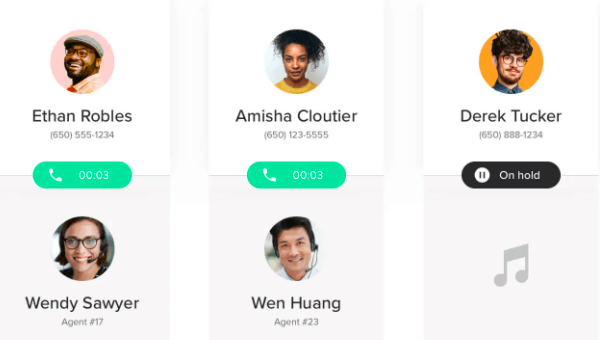
This helps minimize the amount of time that callers are left on hold, which is so crucial since 86% of customers say that being on hold for more than 30 seconds is too long:
To deliver first-rate phone support, there are a few best practices that your call center team should follow. These include:
- Create a better on-hold experience: While it’s essential to do all you can to reduce the time callers are left on-hold, there will be occasions when this is unavoidable. The trick is to make this experience as frustration-free as possible.
One way to keep customers engaged when they are on-hold is to make use of entertaining and informative on-hold messages. For example, you could fend off boredom by sharing an interesting success story or by revealing some surprising facts about your business.
- Build a tailor-made IVR menu: Many call centers will use an automated interactive voice response (IVR) menu to help customers connect to the department they need when they first call for support.
By configuring this menu to reflect the most common kinds of queries you receive, you can drastically improve the experience of those who call. For example, you might ask customers to press 1 for general queries and 2 to hear a list of more specific topics.
RingCentral offers IVR tools to help you edit your automated menus so you can add or remove options as you see fit:
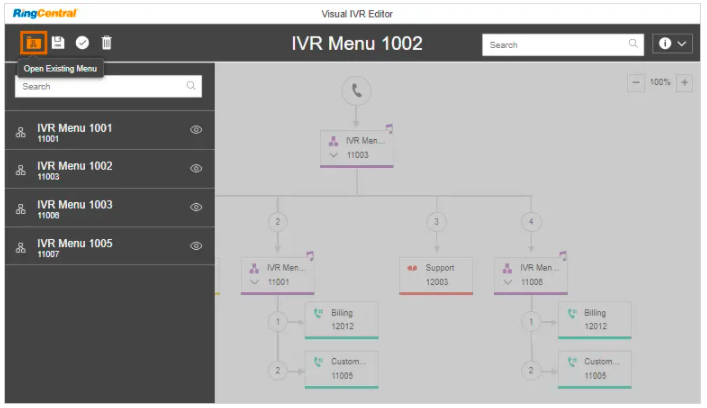
- Post-call surveys: Gathering feedback from customers after a call is one of the best ways to identify gaps in your phone support that you can then use to refine your service.
When should phone support be prioritized?
As mentioned above, phone support is especially useful for handling complex customer queries and for catering to customers who simply prefer to interact verbally with a live person. For this reason, it makes sense for most organizations—whether public or private—to provide at least some level of phone support, even if it’s just reserved for exceptional customer issues.
Example of a company making the most of phone support: Naked Wines
Naked Wines is an online wine retailer focused on supporting independent winemakers. Their customers double up as investors, paying $40 a month for exclusive access to handcrafted wines at reduced prices.
Understandably, the company takes pains to ensure that its customers/investors can receive prompt service whenever they reach out for information. To do this, the service team uses a carefully-designed IVR menu that encourages callers to categorize their type of inquiry, whether it be to sign up as a customer, place an order, or track a shipment.
The company also uses live reporting data to track call volume in real-time, which lets them adapt their staffing arrangements to ensure callers aren’t left on hold for too long. Here’s how that data looks in RingCentral’s dashboard:
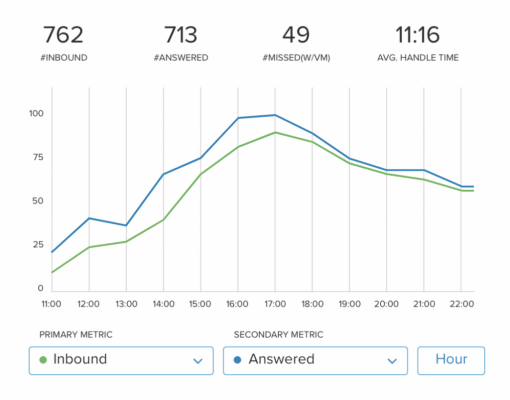
2. Email support
Email is a popular support channel with up to 62% of people identifying it as their preferred way of receiving customer service. The concept is simple enough: customers write an email explaining their problem or request and send it to the listed customer service email address, usually found on the business website.
One of the main benefits of this channel is that it facilitates asynchronous communication (learn more about that here), allowing customers to send requests for support at any time of day or night without the possibility of being put on hold. It also provides customers with a digital record of their interactions with a company, which can often prove useful in the event of a dispute or misunderstanding.
Implementing email support
Many companies will use dedicated email management software to organize their email customer service, which include features like email routing, archiving, and reporting.
RingCentral Digital Engage integrates email communication with other digital channels into one robust cloud customer engagement tool. The platform lets you easily manage large volumes of incoming emails by tracking emails sent and received, classifying incoming emails (based on language, intent, sentiment, and agent skill), and then routing the message to the appropriate team or individual:

Here are some best practices for implementing email customer service:
- Personalize your messages: A great benefit of emails is that they can be automated and sent out en masse at predefined times. However, it’s important to steer clear from sending one-size-fits-all support emails, which just read as lifeless and robotic from a customer’s point of view. Something as simple as referring to your customer (and yourself!) by name can make a world of difference.
- Keep messages short and sweet: A support email should get to the heart of the customer’s issue in as few words as possible. Show that you understand their problem, explain how you’re going to help, provide a call to action (like an invite to call or a request to follow a link), and thank them for their time.
- Follow up: One of the downsides of using email is that important messages can often get buried in cluttered inboxes. It’s always worth sending a quick follow-up email to make sure the customer’s problem has been resolved.
When should email support be prioritized?
Email support is best suited for non-urgent customer queries and for situations in which multiple stakeholders need to be kept in the loop of the conversation. This makes it a popular customer service solution within the B2B space. Email support is also a good fit for companies that have an international customer base who may need to send requests outside of the company’s normal working hours.
Example of a company making the most of email support: Timex
One example of top-notch customer service delivered through email can be seen in the following interaction between an unfortunate Timex customer—whose Timex watch was damaged during a road accident—and one of the brand’s support agents.
Instead of charging the customer for a repair, Timex offered to replace the watch for free and conveyed a great deal of empathy with the customer’s situation. This example demonstrates how a healthy dose of agent autonomy can result in some truly impressive customer service. For more on how you can develop this kind of winning customer service philosophy, check out this post on customer service principles:
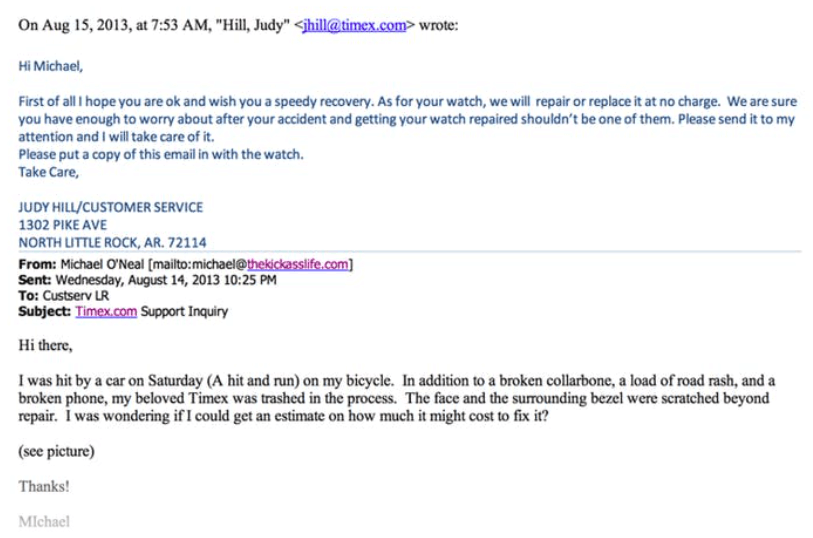
3. Live chat support
Live chat lets customers interact with a support agent in real-time by accessing a chat box on the company’s website. This communication channel shares much of the immediacy you get from a phone call while catering to those who prefer not to interact verbally.
Live chat is particularly popular among younger audiences, with 56% of 18 to 34 year-olds preferring live chat to phone calls. As with emails, live chat leaves a digital footprint of any conversations and allows agents to handle multiple customer conversations at the same time.
Implementing live chat support
Live chat software works by embedding a chat function on your website, with different applications offering features ranging from chat routing and canned responses, to behavioral triggers.
RingCentral’s omnichannel customer service platform integrates live chat with all your other digital communication channels. Agents can get an immediate sense of a customer’s problem or situation by accessing data from their previous interactions, and can even use suggested responses during live chat conversations to keep things moving more quickly:
🕹️ Get a hands-on look at how RingCentral works by booking a product tour:
💰 You can also use this calculator to see roughly how much your business could save by using RingCentral to support your team’s communication with each other—and clients.
Here are a few pointers on how to execute live chat successfully:
- Don’t bite off more than you can chew: Even though live chat creates space for agents to have multiple customer conversations simultaneously (thereby reducing overall response times), you need to strike a careful balance. If agents take on too many customer queries at any given time, the opportunity for mix-ups and delays increases. The priority should be placed on providing swift yet accurate answers to customer questions.
- Make use of automated responses: A significant proportion of live chat queries will be questions that your team has answered many times before. In these cases, your team can save a great deal of time by using a chatbot to deliver canned responses to common questions. You can also use automated chatbots to give customers help during non-working hours.
When should live chat support be prioritized?
Live chat is well-suited for businesses with an online storefront, especially those that target a younger demographic. When potential buyers are browning your products, they’ll often have some questions before they commit to a purchase. This makes live chat an extremely useful tool for converting hot leads.
Example of a company making the most of live chat support: Canyon Bicycles
Canyon Bicycles is a well-loved bicycle brand with fans dotted all over the world. To accommodate the fact that their customers speak a variety of different languages, the company makes use of a language-based routing system within their live chat to automatically connect customers to the best-suited agent available.
4. Self-service
The self-service approach to customer service is all about helping customers help themselves. This generally entails building an online knowledge base consisting of articles about your product, service, and other aspects of your business. Your customers can then simply choose to look up relevant articles at their own pace whenever they have a problem.
elf-service is popular with customers, with 72% preferring to find answers themselves as compared to calling or emailing a support agent. After all, most customer questions only need a simple answer, and so finding the answer themselves is often less time-consuming than reaching out to a real-life support agent.
From a customer service team’s point of view, self-service solutions can drastically reduce ticket volume and free up time for agents to deal with more unique and urgent customer inquiries.
Implementing a self-service solution
Building a comprehensive and user-friendly knowledge base takes a fair deal of planning and maintenance. That said, you can always start off with just a few articles that tackle some of the most common customer questions and concerns and then build on that over time.
Here are some things to keep in mind if you choose to create a knowledge base:
- Prioritize intuitive navigation: When determining the layout of your knowledge base, you should think carefully about how users will actually use it. It’s good practice to start with a “hub” page that features a search box, links to popular articles, and links to category pages arranged by topic areas.
- Format articles to be easy to skim: Clearly, you want your help articles to be easily understood by those who read them. The information should be arranged in a clear and consistent format, making use of plenty of bullet points, numbered lists, and subheadings. When it comes to writing style, focus on clarity and brevity.
When should self-service be prioritized?
Self-service solutions are a good fit for most organizations. They are perhaps best suited for companies that offer a wide range of products or services with a higher degree of technical complexity.
Example of a company making the most of self-service: Asana
Flaunting one of the finest knowledge bases around, Asana keeps all its support documentation, user guides, interactive courses, and live-streamed tutorials within the beautifully designed Asana Guide section of its website:
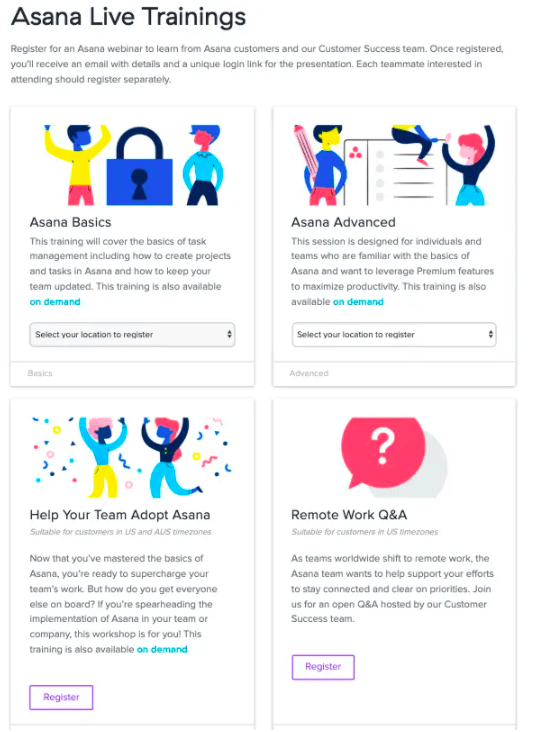
Ready to experiment with different types of customer service?
Building an effective customer service model is a vital part of running a successful business. If you get customer service wrong, the consequences can be dire. But if you get it right, the rewards can be great.
Figuring out which types of customer service are the best fit for your company depends on factors like your customers’ preferences, your budget constraints, and the nature of the products or services you sell.
However, for most organizations, relying on just a single customer service channel isn’t enough. As we’ve seen, different types of customer service offer different benefits. So, ideally, your customer service model will consist of a mix of service types that complement one another.
Omnichannel customer service platforms offer a flexible solution to the problem of implementing more than one type of customer service. See how they work by booking a product tour!
Originally published Jan 06, 2021, updated Jun 24, 2024


